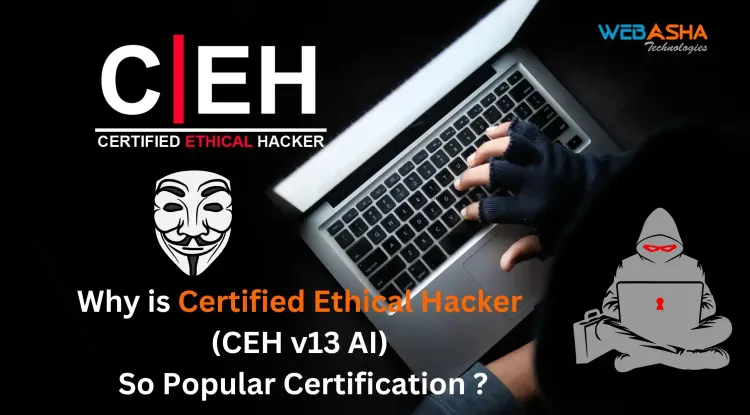Target Selection and Risk Assessment in Penetration Testing | A Comprehensive Guide for CEH Master Certification
Penetration testing plays a crucial role in cybersecurity by identifying vulnerabilities before malicious actors exploit them. This blog provides an in-depth guide to target selection, penetration test planning, security exceptions, risk assessment, tolerance determination, and scope creep, essential topics covered in the CEH Master certification syllabus. The article explains internal vs. external testing, how to define test scope, schedule tests, and manage security exceptions during ethical hacking. It highlights risk assessment techniques, including risk avoidance, transference, mitigation, and acceptance, while covering strategies to manage scope creep in penetration tests. This guide is essential for ethical hackers, cybersecurity professionals, and CEH Master candidates aiming to master penetration testing methodologies.

Table of Contents
- Penetration Test Planning
- Security Exceptions in Penetration Testing
- Risk Assessment in Penetration Testing
- Determining Tolerance in Penetration Testing
- Scope Creep in Penetration Testing
- Conclusion
- FAQs:
Penetration testing is a crucial aspect of cybersecurity, helping organizations identify vulnerabilities before malicious hackers can exploit them. However, before launching a penetration test, security professionals must carefully plan and define the test’s scope, risk tolerance, and methodology.
This guide provides an in-depth look at target selection, penetration test planning, security exceptions, risk assessment, tolerance determination, and scope creep, essential topics covered in the CEH Master certification syllabus.
Penetration Test Planning
Before executing a penetration test, it’s essential to outline key aspects such as the test type, scope, and constraints. The planning phase answers the following questions:
-
How will the test be conducted? (Internal vs. External)
-
Who will be aware of the test?
-
What systems will be targeted?
-
When will the test be scheduled?
-
Where will the test take place? (On-site vs. Remote)
How: Internal vs. External Penetration Testing
The type of penetration test depends on the organization’s security goals and the environment being tested:
-
Internal Testing: This simulates an attack from within the organization, assuming the attacker has gained some level of access to the internal network.
-
Example: An attacker who has stolen an employee’s login credentials tries to escalate privileges.
-
Approach: Usually a white-box test, where the tester has detailed knowledge of the internal network.
-
-
External Testing: This focuses on public-facing assets, such as web servers, email servers, and externally accessible APIs.
-
Example: A hacker attempts to exploit a web application vulnerability to gain access.
-
Approach: Typically conducted as a black-box test, where the tester has no prior knowledge of the system.
-
Who: Social Engineering and Awareness Considerations
Organizations must determine:
-
Whether the penetration tester is allowed to use social engineering techniques (e.g., phishing attacks, impersonation, pretexting).
-
Which employees or security teams will be informed about the test to ensure realistic attack scenarios.
Example: If social engineering is permitted, an ethical hacker might send a phishing email to employees, attempting to steal login credentials.
What: Defining the Targeted Systems
The scope of the penetration test must be clearly defined to ensure:
-
The tester knows exactly which systems can be tested.
-
Critical infrastructure (such as financial databases) is protected.
-
Third-party applications and cloud environments are considered.
Example: A company may exclude payment processing servers from testing due to potential legal or compliance issues.
When: Scheduling the Penetration Test
Timing is critical for minimizing business disruption. Organizations must decide whether to:
-
Conduct the test during business hours, risking operational impact.
-
Perform the test after hours, on weekends, or during holidays to avoid downtime.
Example: A retail company might prefer testing after peak shopping hours to prevent revenue loss.
Where: On-Site vs. Remote Testing
-
On-Site Testing:
-
Provides full access to internal systems.
-
Allows physical security assessments (e.g., tailgating into secure areas).
-
Example: A penetration tester walks into a data center, attempting to bypass security controls.
-
-
Remote Testing:
-
More cost-effective but limited by network restrictions.
-
May require VPN access or other remote access mechanisms.
-
Example: A tester attempts to gain access to an organization’s cloud infrastructure from an external location.
-
Security Exceptions in Penetration Testing
Security exceptions define rules and limitations for penetration testers. The type of test—white-box, black-box, or grey-box—determines what exceptions apply.
-
White-box testing: The tester has full access to system details, including source code and network architecture.
-
Black-box testing: The tester has no prior knowledge of the environment and must rely on reconnaissance techniques.
-
Grey-box testing: The tester has partial knowledge (e.g., some credentials or documentation).
Security exceptions may include:
-
Bypassing firewalls
-
Using brute-force attacks (restricted in some environments)
-
Exploiting vulnerabilities in live production systems
Example: A penetration tester is allowed to test internal networks but not customer databases due to privacy concerns.
Risk Assessment in Penetration Testing
A risk assessment identifies an organization’s most vulnerable areas, including:
-
High-value data (financial records, intellectual property)
-
Network infrastructure (routers, firewalls, cloud environments)
-
Web applications and online services
-
Physical security (access control, CCTV systems)
Risk Management Strategies
Once vulnerabilities are identified, organizations must decide how to handle them. The four main risk management strategies are:
-
Avoidance: Eliminating the risk by not engaging in activities that create it.
-
Example: A company disables USB ports on workstations to prevent malware infections.
-
-
Transference: Shifting risk to a third party, such as a cloud provider or cyber insurance company.
-
Example: A business outsources its DDoS protection to Cloudflare.
-
-
Mitigation: Reducing the impact of a risk through security controls.
-
Example: Implementing multi-factor authentication (MFA) to reduce credential theft.
-
-
Acceptance: Choosing to accept a risk if mitigation is too costly.
-
Example: A legacy system remains unpatched due to compatibility issues with critical business applications.
-
Determining Tolerance in Penetration Testing
Organizations must define which risks they can tolerate during a penetration test.
-
Critical systems (e.g., real-time transaction databases) may be off-limits.
-
Non-critical systems can be tested with controlled exploits.
Example: A hospital may allow testing on backup servers but restrict penetration testers from targeting live patient records.
Scope Creep in Penetration Testing
What is Scope Creep?
Scope creep occurs when new tasks or objectives are added to the penetration test after planning has been finalized. This can lead to:
-
Increased costs
-
Extended timelines
-
Resource overload
Managing Scope Creep
To avoid scope creep:
-
Define a clear testing scope before starting.
-
Require formal approval for scope changes.
-
Ensure additional tasks are documented and approved.
Example: A client initially requests network security testing, but later asks for a full web application assessment, significantly increasing the workload.
Conclusion
Penetration testing is a structured process that requires careful planning, defined scope, and risk assessment. Ethical hackers must determine which systems to target, who will be informed, and what security exceptions are allowed.
A thorough risk assessment ensures that organizations prioritize vulnerabilities and minimize disruptions. Managing scope creep prevents unexpected costs and project delays.
For CEH Master certification candidates, understanding target selection, risk assessment, and penetration testing methodologies is essential to becoming a successful ethical hacker.
FAQs:
What is penetration testing?
Penetration testing, or ethical hacking, is a simulated cyberattack used to identify vulnerabilities in an organization's security infrastructure.
What are the different types of penetration tests?
The main types are internal testing (simulating an insider attack) and external testing (simulating an outside hacker attack).
What is the difference between white-box, black-box, and grey-box testing?
White-box testers have full knowledge of the system, black-box testers have no prior knowledge, and grey-box testers have partial knowledge.
Why is penetration test planning important?
Proper planning ensures that tests are conducted within a defined scope, avoiding unnecessary risks and ensuring compliance with security policies.
How is the scope of a penetration test determined?
The organization and tester agree on which systems can be tested, how attacks will be simulated, and any limitations to avoid disruptions.
What are security exceptions in penetration testing?
Security exceptions define which actions a tester is allowed or restricted from performing, such as bypassing firewalls or exploiting critical systems.
Can penetration testers use social engineering techniques?
It depends on the agreement with the organization. Some tests include phishing and impersonation attacks to assess human vulnerabilities.
What is the impact of penetration testing on live systems?
Uncontrolled tests can cause system disruptions. Ethical hackers ensure that tests do not affect critical operations.
Why is risk assessment necessary before penetration testing?
Risk assessment helps identify critical assets, evaluate threats, and determine acceptable risks before running security tests.
What are the four main risk management strategies?
Risk avoidance (eliminate risk), transference (shift risk to a third party), mitigation (reduce risk impact), and acceptance (tolerate risk).
What is the role of vulnerability assessment in penetration testing?
Vulnerability assessment helps identify security weaknesses before conducting a penetration test to prioritize risks.
How does risk transference work in cybersecurity?
Organizations can shift risk by outsourcing security measures to a third party, such as hiring managed security services.
What factors influence an organization's risk tolerance?
Business impact, regulatory requirements, and risk appetite determine how much risk an organization is willing to accept.
How do organizations decide which systems can be tested?
They define test parameters based on critical infrastructure, business continuity, and compliance requirements.
What is the importance of defining security boundaries?
Security boundaries prevent penetration testers from accessing unauthorized systems or causing unintended damage.
Can penetration tests be conducted on production systems?
It depends on risk tolerance. Some organizations prefer testing in a controlled environment to avoid disruptions.
How do ethical hackers handle sensitive data during testing?
They follow strict data handling policies and ensure no unauthorized access or data leaks occur.
What is scope creep in penetration testing?
Scope creep occurs when additional testing requirements arise after the test begins, increasing costs and time.
How can organizations prevent scope creep?
By clearly defining the test scope, setting expectations, and requiring approval for any changes.
What are the risks of an undefined penetration test scope?
It can lead to security misconfigurations, unintended data exposure, and legal issues.
Why is a formal approval process needed for scope changes?
To ensure that additional tasks do not interfere with business operations and compliance requirements.
What is an example of internal penetration testing?
Testing an internal HR database to see if employees can escalate privileges beyond their assigned roles.
How does an external penetration test work?
Ethical hackers simulate an attack from outside the organization, targeting public-facing systems like websites and email servers.
What is a real-life example of social engineering in penetration testing?
An ethical hacker sends a phishing email to employees to test their ability to detect suspicious messages.
How do ethical hackers test database security?
They use SQL injection and privilege escalation techniques to determine if an attacker can access sensitive data.
What is an example of a risk mitigation strategy?
Implementing multi-factor authentication (MFA) to reduce the risk of credential theft.
How do organizations handle discovered vulnerabilities?
They prioritize patches based on risk levels and implement compensating controls if immediate fixes are not possible.
What is the role of compliance in penetration testing?
Organizations must ensure that penetration tests align with industry regulations such as GDPR, HIPAA, and PCI DSS.
Can penetration testing help in regulatory audits?
Yes, penetration test reports provide evidence of security assessments and compliance with industry standards.
Why is penetration testing critical for cybersecurity?
It proactively identifies security weaknesses before they can be exploited by malicious hackers.













![Top 10 Ethical Hackers in the World [2025]](https://www.webasha.com/blog/uploads/images/202408/image_100x75_66c2f983c207b.webp)

![[2025] Top 100+ VAPT Interview Questions and Answers](https://www.webasha.com/blog/uploads/images/image_100x75_6512b1e4b64f7.jpg)








